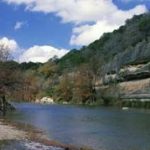State: Texas
Address 1: 3350 Park Rd 31
City: Spring Branch
Zip: 78070
Phone: 830-438-2656
Open all Year: Yes
Number of Sites: 100
Electric Water: 48
Full Hook: 4
Camp URL: http://www.tpwd.state.tx.us/spdest/findadest/parks/guadalupe_river/
Full Hook: Yes
About: The park has 4 miles of river frontage and is located in the middle of a 9-mile stretch of the Guadalupe River. Park visitors may enjoy a variety of outdoor activities including canoeing, fishing, swimming, tubing, picnicking, hiking, and camping. The park recently opened a 5.3 miles equestrian trail that is also open to mountain biking. No equestrian camping is available at the park. Opportunities also exist for less vigorous but more serene pursuits, such as bird watching and nature study. Tours: There is a two-hour guided interpretive tour of the adjacent Honey Creek State Natural Area. The tour emphasizing history, geology, flora, and fauna is given Saturday at 9:00 a.m.; call park to confirm.
Convenient access to the Guadalupe River is available from the day-use area which has picnic sites and ample parking. For longer visits, there are camping areas to suit different preferences, and Campsites with water and electricity can accommodate recreational vehicles and trailers; another area has campsites with water for tent campers, and a separate area with walk-in tent campsites with water in the area. Drinking water and sanitary facilities are provided at the picnic and camping areas, and the restrooms at the water or water and electricity campsite areas have showers. The park also has a trailer dump station, 3 miles of hiking trails, and a Texas State Park Store which has quality gifts, nature items, and books for children and adults.
The Guadalupe River, with banks lined by huge bald cypress trees, is the park’s most outstanding natural feature. On its winding path through the park, the river courses over four natural rapids; and two steep limestone bluffs reflect its awesome erosive power. Trees in lower elevations and bottom lands include sycamore, elm, basswood, pecan, walnut, persimmon, willow, and hackberry. In the uplands away from the river, the limestone terrain is typical of the Edwards Plateau and has oak and juniper woodlands, with interspersed grasslands.
One area of virgin Ashe juniper woodland provides the proper nesting habitat for the rare golden-cheeked warbler. In addition to numerous species of birds, the park supports a wide variety of wild animals including white-tailed deer, coyote, gray fox, skunk, raccoon, opossum, bobcat, and armadillo. Other smaller species abound, and efforts of wildlife observers are usually well-rewarded.


